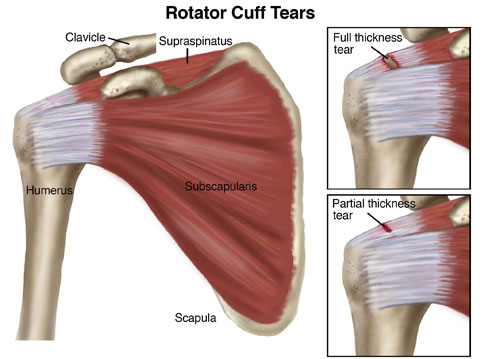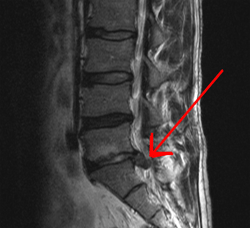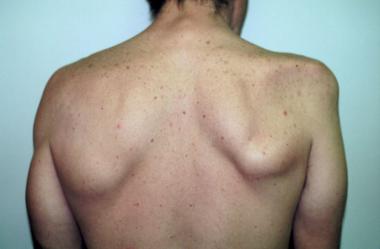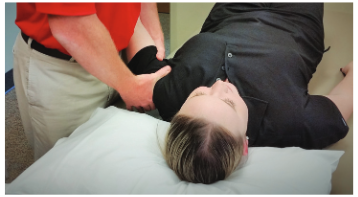|
BOOK NOW |
ASK ABOUT YOUR PAIN |
Home > Blog > Physiotherapy > Conditions > Shoulder Pain > Shoulder Blade Pain
Shoulder Blade Pain Physiotherapy

Shoulder blade pain is fairly common problem that patients may experience.
It can be caused by
- an issue in the shoulder blade itself
- soft tissues surrounding the shoulder blade
- referred pain by other organs or muscles such as neck issues or lung-related issues
- muscle strain
- slept in an awkward position or poor ergonomics
Unfortunately it can be something more insidious such as cancer, infections or even heart issues.
Let's study the anatomy of the shoulder blades before looking at the most common causes of pain in the shoulder blade area so we can slowly determine if your shoulder blade pain is caused by
- bony issues
- soft tissue issues
- nerve issues
- infections
- postural or ergonomical problems
- etc
Shoulder Blade Anatomy

Our shoulder blades (medically termed it is the scapula bone) refers to an integral part of the shoulder joint. The bulk of the bone is triangular in shape and sits over the back part of our ribcage, but there are three protrusions at the top:
- Glenoid Fossa is a shallow cavity that fits with the top of the upper arm bone (humerus), forming the shoulder joint (a ball and socket joint)
- Acromion is an oblong projection over the top of the shoulder that forms a bridge over the rotator cuff muscles and forms a joint with the collar bone (clavicle)
- Coracoid Process is a smooth hook shaped protrusion at the front of the shoulder
There are a total of eighteen (18) different muscles that connects and attach to different parts of the shoulder blade, and each scapula can move
- up (scapular elevation)
- down (scapular depression)
- forwards (scapular protraction)
- backwards (scapular retraction) and also the scapula can
- twist (upward and downward scapular rotation).
Common Causes of Shoulder Blade Pain
Shoulder blade pain can often confuse patients because there is a few different types of causes, aggravators and influencing factors.
For your convenience, we have listed them into the following groups:
- Muscle Problems:
Patients experience a type of dull ache that seems to get aggravated and worse with arm movement and improves with rest. This tends to affect only one arm or shoulder as to both at the same time. - Nerve Problems:
Nerve issues and problems tend to have sensations such as tingling, pins and needles, numbness and weakness. Symptoms may travel (also termed as "refer") to other areas near and around the shoulders. It may affect one or both shoulders or arms at the same time. - Bursitis:
Patients with shoulder bursitis may report a constant, dull aching shoulder blade pain that may be associated with snapping, grinding (crepitus) or grating noises or sensation with forms of arm movements - Posture:
Patients may report experiencing an aching pain between their shoulder blades, that seem to worsen after being in one position for a long time (such as working at the computer for some time) - Bone Problems:
Patients may experience a sudden, severe and/or sharp localised pain following an injury or accident - Medical Disorder:
Patients may report experiencing associated symptoms such as feeling unwell, chest pain, dizziness, nausea, weight loss and shortness of breath
We will cover more of them in detail below:
Muscle Problems
Patients with muscle problems will experience a type of dull ache that seems to get aggravated and worse with arm movement and improves with rest. This tends to affect only one arm or shoulder as to both at the same time.
1) Muscle Strain
Patients experience dull, aching pain in shoulder and/or shoulder blade that seems to be aggravated with arm movements and improves with rest. It is rare for their shoulder pain to travel down the arm
Overuse or over stretching of muscles can cause pain in the shoulder blade area. This usually develops due to overworking the muscles, most commonly from
- a new exercise regime
- repetitive overhead arm activities
like throwing or lifting weights/load
- carrying something heavy like a backpack
- sleeping awkwardly
Patient reports that it tends to be a dull ache around one or both shoulder blades that gets worse with activity and improves with rest, and the area may be tender to touch.
Typically, these pains and symptoms don’t travel downwards into the arm.

Patients report experiencing pains that are deep, dull and ache across their shoulders and shoulder blade, as well as hearing/experiencingcrepitus (popping/cracking noises) that get worse with arm movements. Patients may also experience arm weakness may develop. These sort of conditions may develop suddenly with an injury, or gradually with use/degeneration.
Our rotator cuff is a group of muscles that work together to move the shoulder joint. If any one of them is torn or injured, typically from prolonged repetitive arm work or an injury, it is likely to be tender and painful around the shoulder.
This pain may travel down the arm and to the shoulder blade region, but only on one side.
3) Trigger Points

Trigger points, which is also called myofascial trigger points, refers to pea size lump in the muscle which is tender to touch, which are typically formed when muscles are sustained in shortened positions due to overuse or poor or awkward position (ergonomics). Patients typically experience dull, deep, aching pain which may travel down the arm or up the neck.
Trigger points are small, tight bands in the muscle fascia which can be extremely sensitive to any touch. They are commonly found and cause pain in the shoulder blade area, usually described as a dull, deep, aching pain which may extend down on arm.
Nerve Impingement
Patients with nerve issues and problems tend to have sensations such as
- tingling
- pins and needles
- numbness and
- weakness
Symptoms may travel (also termed as "radiating" pain) to other areas near and around the shoulders. It may affect one or both shoulders or arms at the same time.
It is pretty common for shoulder blade pain to originate from irritation of the nerves that come from the neck or upper back. These nerves commonly refer pain to the shoulder blade area and may also have sensations such as
- tingling
- pins and needles
- numbness and/or
- weakness
Our spinal cord runs down the centre of our spine, with spinal nerve roots branching out at each spinal level which extend out like wires / cables. Electrical signals in form of impulses run up and down these nerves to and from the spinal cord and brain controlling movement and sensation (touch).
There are a number of different things that can cause nerve damage which results in shoulder blade pain:
1) Disc Disease
Patients with spinal disc diseases may experience
- spinal pain
- pins
- needles/tingling
- numbness and
- weakness
- all of which may spread to the shoulder blade and down the arm (usually one side only).
These symptoms may worsen with activities such as coughing or sneezing, and neck movements may not cause or aggravate any pain in the neck...even if that is where the problem originates from.
Between each bone in your spine (vertebra) sits a squashy, jelly-filled/like spinal disc – you can imagine it like a jam donut. What these spinal disc does is that it creates sufficient space and cushioning between the bones and ensures there is minimal pressure on the nerves where they come out of the spine.
However, that being said, there are two (2) common problems develop in the discs that can lead to shoulder blade pain:

a) Disc Protrusion: ie herniated spinal disc or slipped disc.
This happens when a tear happens in the outer layer of spinal the disc (at the edge of the donut). As a result of this, the central part of the disc known as the nucleus pulposus (imagine it like the jam in a jam donut) bursting, spilling and bulging out of the Spinal disc.
In severe cases it may even seep out, known as spinal disc herniation. Both occurrences will cause increased pressure on the spinal nerve root resulting in irritation. In most cases, this is a gradual process, but it can be caused by an injury such as
- falls
- sports injuries
- motor-vehicle accident
- heavy lifting
It is a misleading and confusing idea that the spinal disc "actually" slips out of place...but actually, the spinal disc doesn't and cannot "slip out" like ever...cos the spinal discs are locked very firmly in place. Yes, these spinal discs can be stretched and squeezed, but they never slip out of place.
b) Disc Degeneration: What happens is that as we age, the spinal disc unfortunately starts to also age and wear out, leading it to:
- dehydrate
- weakening
- thins out and
- shrinks
This causes the space between the vertebrae to shrink (this also helps to clarify and explain why we shrink as we age), and this can place pressure on the nerves, and increases the risk of disc protrusion.
Read more: Degenerated Disc Disease
2) Spinal Stenosis
Patients will experience a progressive and radual onset of pain in the shoulder blade, shoulder, arm and hand, and it typically affect both shoulders and arms. In some rare and severe cases, patients may find their balance,bladder and bowel function may also be affected. Patients typically report that their symptoms worsen when standing and ease with sitting. Spinal stenosis usually affects those over the age of 50.
Spinal stenosis occurs when there is abnormal narrowing of the spinal canal (this refers to the space in the middle of the vertebra where our spinal cord passes through). Spinal stenosis may be caused by
- ageing
- arthritis
- spinal instability
- trauma or
- genetics (hereditary)
Symptoms tend to be at their worst when standing and include shoulder, arm, hand and shoulder blade pain, numbness, weakness, balance problems and in severe cases can affect bladder and bowel function. In most cases, symptoms are bilateral (on both sides).
Related article: Spinal Stenosis
Patients will experience sudden, severe, stabbing and/or sharp shoulder pain that may spread and travel to their
- neck
- arm and
- shoulder blade
They also report experiencing weakness and winging (protruding) of their scapula, as well as difficulty moving especially with scapular-related movements.
Patients may also experience altered sensation such as burning, hot, cold, tingling etc, and these symptoms tend to be ongoing/constant.

Brachial Neuritis refers a rare condition where there is inflammation of
the brachial plexus, an area where our nerves from the bottom of the
neck pass across the front of the chest. In some cases, brachial plexus neuritis develop due to genetics
(hereditary) or an abnormality in the immune system.
Symptoms usually develop suddenly, most commonly at night.
Most of the initial symptoms tends to revolve around/start at the
- shoulder
- neck
- arm and
- shoulder blade
which gets progressively worse with any arm movement, and after a few days/weeks, patient may develop weakness which then lead to scapula winging, making it hard to move the arm normally.

Sensation may also be affected with tinging or numbness. There tends to be little respite from symptoms and the pain may only respond to strong painkillers.
Related article: Brachial Neuritis
4) Upper Thoracic Syndrome aka T4 Syndrome
Classic Symptoms: Widespread pain, altered sensation, muscle spasms and headaches that get worse with movement of the upper and middle back such as twisting. Symptoms are usually at their worst at night time. Typically affects people between ages of 20-40
T4 syndrome is a rare condition that results in a complex pattern of painful symptoms including shoulder blade pain. The thoracic spine forms the middle and upper back area, starting just below the neck. There are 12 thoracic bones (vertebra). T4 syndrome typically refers to damage or irritation around the fourth thoracic vertebra, although the problem may come from anywhere between T2-T7.
Symptoms usually affect one arm, but can sometimes affect both, and tend to include diffuse (meaning it’s hard to pinpoint where the pain is coming from) arm, neck and shoulder blade pain, tingling/pins and needles/numbness, stiffness, muscle spasms and headaches. Pain often gets worse when pressure is applied directly to the T4 vertebra.
Symptoms tend to worse at night and are exacerbated by any movements of the upper and middle back such as twisting, bending, laughing, coughing and activities such as driving where the arms are reaching forwards and lifting. T4 syndrome is thought to be caused by factors such as stiffness, hypermobility, poor posture, repetitive bending/heavy lifting.
Scapulothoracic Bursitis aka Snapping Scapula
Patients with shoulder bursitis may report a constant, dull aching shoulder blade pain that may be associated with snapping, grinding (crepitus) or grating noises or sensation with forms of arm movements
Patients typically report experiencing a snapping, grating and/or grinding noise or sensation around the shoulder blade, constant, dull aching shoulder blade pain.
Around our shoulder blade there are few bursa, and they are small, fluid-filled sacs that sit between soft tissues and bone to help improve/allow smooth, friction-free movement of joints, tendons and muscles.
Sitting right in front of our scapula bone is a large muscle called subscapularis.
There are two bursa, one near the top of the scapula and one at the bottom that allow the scapula to glide smoothly over the rib cage. If there is any irritation or inflammation of the bursa, maybe due to
- muscle weakness
- muscle tightness
- poor posture or
- bony abnormalities
- that can cause or aggravate persistent, dull, aching shoulder blade pain and a snapping or grating noise with arm movements. Patients may also find that a lump on the shoulder blade.
Poor Posture
Patients may report experiencing an aching pain between their shoulder blades, that seem to worsen after being in one position for a long time (such as working at the computer for some time)

Typically patients report an aching pain between their shoulder blades, particularly after being in the same position from prolonged periods such as working on their laptops, computers, mobile devices and even reading.
Poor posture can and will lead to shoulder blade pain.
We treat a lot of patients who spend a lot of their working (and even at home) being hunched in sitting or standing, gardening, reading - poor ergonomics and posture does cause and contribute to shoulder blade pain.
The typical postures that cause shoulder and shoulder blade pain:
- rounded shoulders
- shoulders rolled forward
- anterior (forward) chin protusion
Done repeatedly and over time, this causes our chest and upper back muscles to weaken and our spine to stiffen, typically the lower neck and upper back which can lead to aching shoulder blade pain, particularly across the upper back just in between the shoulder blades.
shoulder bony / bone Fractures

Patients may experience a sudden, severe and/or sharp localized pain following an injury or accident
Patients typically report experiencing sudden, severe and/or sharp pain that happens together with an audible snap/pop/click sound. Patients may see an obvious deformity. Shoulder blade pain usually becomes aggravated and worsens with any pressure over the scapula such as lying on your back.
Our shoulder blades are amongst the most difficult bones in the body to break (typically they fracture only with direct blows), so fractures in the scapula typically are very rare.
It is close to impossible to break your shoulder blade without being remotely aware about it, and most of the time, scapular fractures happen due to a
- falls
- direct blows
- collision
- sports injuries
- motor vehicle accident
Scapular fractures are often accompanied by other injuries which may be serious such as rib fractures and lung injuries too.
Medical Issues
Patients may report experiencing associated symptoms such as
- feeling unwell
- chest pain
- dizziness
- nausea
- weight loss and
- shortness of breath
Organ disorders can and does often cause referred shoulder blade pain.
They will usually have other accompanying symptoms as well, so if your only complaint is pain in the shoulder blade area, it is unlikely to be caused by any of these.
1) Heart Problems
Many patients and individuals often think heart heart problems are associated with chest pain and left shoulder/arm pain, but shoulder blade pain is often a reported symptoms with heart problems, particularly moreso in women.
The most common heart problem that causes pain in the shoulder blade area is a heart attack, where there is decreased blood flow to the heart either due to a clot or bleeding.
Other heart problems that can cause shoulder blade pain include
- pericarditis (inflammation of the lining of the
heart) and
- aortic dissection (a tear in the aorta, the main artery that carries blood away from the heart)
If your chest and/or shoulder blade pain are severe, come on suddenly, dizziness, shortness of breath, rapid pulse, sweating, chest tightness or nausea, please call 911 immediately.
2) Lung Problems
Lung problems can also lead to referred shoulder blade pain. Lung problems that are often associated with pain in the shoulder blade area include:
- Pancoast Tumours is a type of lung tumor that grows on the top part of the lungs and usually
affects smokers and is associated with feeling generally unwell, weight
loss and eye problems
- Pleurisy
refers to inflammation of the lung lining – patients report sharp chest pain
when breathing deeply which may travel to the shoulder and/or shoulder blades
- Pneumothorax is a collection of air between the lung and the chest wall (pleural cavity) which causes part of the lung to collapse. Usually presents with sudden pain and shortness of breath and there may be a sharp pain between shoulder blades
Some types of cancer can travel and spread to the bone known as metastases.
Cancers that typically spread to the scapula causing shoulder blade pain include
- breast cancer
- lung cancer
- colon cancer and
- oesophageal cancer
Shoulder blade pain from metastases is usually worse at night and will be accompanied by
- fatigue
- weight loss
- nausea
- vomiting
- lack of appetite
4) Abdominal Conditions
Problems in the abdominal organs can result in referred shoulder blade pain.
Left shoulder blade pain may be caused by pancreatitis or irritable bowel syndrome (IBS) and right shoulder blade pain may be due to
- gallstones
- peptic ulcers
- liver disease such as liver cancer
physiotherapy for shoulder blade pain

Patients may also receive the following physiotherapy treatment modalities:

- hands on manipulation and mobilization (manual therapy)
- soft tissue management
- heat therapy and heat treatment and heat pack to relief tight muscles and joints
- ultrasound therapy to accelerate soft tissue healing
- exercise therapy
- acupuncture
- dry needling
- deep tissue release
- and more
References